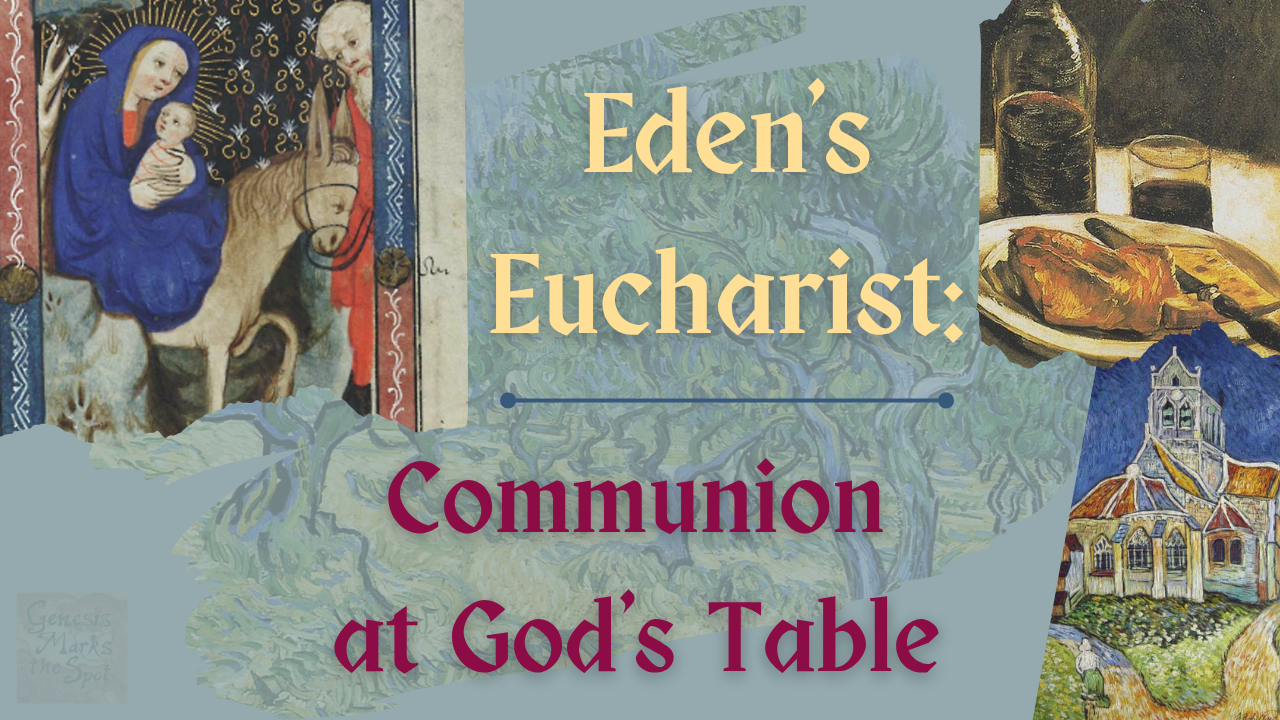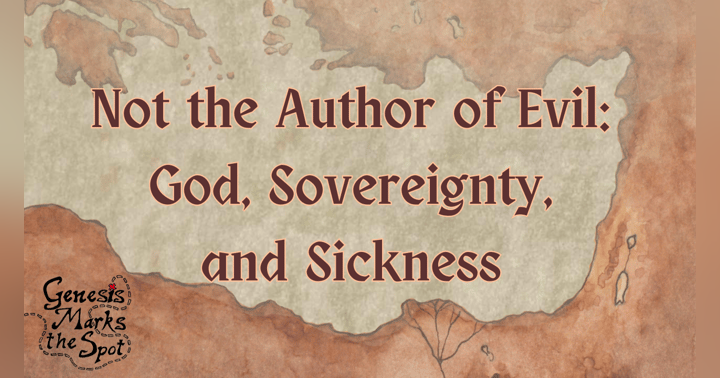Eden's Eucharist - A Conference Lecture

From the First Supper to the Last: The Threefold Body of Christ
What if I told you that the whole story of salvation--the arc from Eden to New Creation--could be followed through meals? That a table, of all things, might be the thread that ties together humanity’s fall and God’s redemptive love?
Welcome to Beyond the Gates of Eden, where we explore biblical theology not just as abstract ideas, but as embodied truth....truth we can taste, touch, and live. And in my lecture in the series, we’re going to pull up a chair and reflect on the threefold body of Christ.
-
The incarnate body of Jesus – God in the flesh, who lived, died, rose, and ascended
-
The communal body of the people of the church – his people on earth, living in union with him
-
The sacramental body in the meal – the bread and wine shared as his body and blood
We begin with his incarnate body--Jesus, God in the flesh, born into history, walking dusty roads, breaking real bread. Then there’s the communal body--the church, his ongoing presence in the world, living and breathing as his people. And finally, the sacramental body--the bread and the wine, the meal of communion, where we receive and remember and participate in him.
I love metaphor and imagery because they are more than dry fact. These elements are things we're used to talking about in church, but how often do we stop to wonder why they're all described in cross-over ways? The theme of God dwelling with us is one of my favorites in Scripture, history, and my faith life. Even though God doesn't need to eat to sustain himself, we do. And so this imagery of body and bread and community is one that brings together essential things to us.
The First Supper and the Long Road Back
Let’s go back to the first shared meal in Scripture.
It’s not what we’d hope for. It’s not a feast with God in Eden’s peace, but a devastating bite taken in the presence of a serpent. Genesis 3 is often read through the lens of disobedience (and we're not challenging that here). But if we look closely, we see something even more intimate unfolding: the first table fellowship, and it's disordered. It's not good, as opposed to the good of creation.
A meal that was meant to bring wisdom was taken on human terms and becomes a turning point toward exile, a major theme in Scripture and one which many of us deeply relate to. Abandonment. A feeling of not belonging. The table that was set for life is overturned and it becomes insstad a table of death.
But even here, it’s not the end of the story.
God doesn’t walk away from meals with his people.
Outside the garden, sacrifice emerges. This is not a morbid obsession with death, but it's a way to share a meal with the divine. Shared food. A holy barbecue, if we’re being honest. The smoke rising isn’t about loss, but about fellowship.
Melchizedek meets Abraham with bread and wine. Presence and provision. The Passover meal becomes a shield against destruction, forming Israel’s collective identity. Manna rains down like dew in the wilderness, sustaining bodies and reshaping hearts. And David, hungry and hunted, is sustained by the holy bread of presence.
God keeps drawing near again and again.
Jesus: The Body Given and the Meal Shared
This is the first layer of the threefold body: the Incarnate Christ.
When Jesus comes, he ushers in the Kingdom and institutes the royal feast. He feeds the poor, dines with sinners, and breaks Sabbath bread in defiance of false piety.
in an upper room on the night of his betrayal, Jesus lifts the bread and says something that echoes across every communion table since: “This is my body, given for you.”
He doesn’t say, “This represents something spiritual.” He says, “This is me. My body. My offering.” In a garden not unlike Eden, Jesus surrenders that body in obedience. He is handed over, pierced, lifted up.
This is the first movement in the threefold body of Christ: the Incarnate One. Flesh and blood. Born to Mary. Walking among us. Touching lepers. Weeping at tombs. Carrying a cross.
The Word made flesh, a body broken so that we might be made whole.
The Church: His Body on Earth
The Church is now the second layer: the corporate body. We live as his hands and feet in the world, eating together, worshipping together, suffering together.
After the resurrection, something remarkable happens. Jesus ascends, but his body doesn’t disappear; it multiplies.
In Acts and the Epistles, we see the language shift. The body of Christ becomes something that spreads across cities and centuries. It fills homes and synagogues, deserts and marketplaces.
We are now his hands and feet, his presence and action in the world. And we embody his message. We eat together. We worship together. We suffer and rejoice together. And in doing so, we become a kind of living sacrament, a tangible sign that Christ is still moving, still healing, still speaking.
The Church isn’t perfect. Far from it! But in its truest form, it is Christ’s body continuing his mission: to seek, to save, to serve. We are to be bread for the hungry, light for the weary, and fellowship for the lonely. We belong to Jesus, and in Christ we are his body.
The Eucharist: A Meal of Memory and Mystery
And now we come to the third layer, the place where the story folds in on itself and points us forward all at once.
The Eucharist--whether you call it Communion, the Lord’s Supper, or simply the Table--isn’t just a symbol. It’s participation. It’s presence. It’s real.
Paul writes in 1 Corinthians 10:16, “Is not the cup of thanksgiving for which we give thanks a participation in the blood of Christ? And is not the bread that we break a participation in the body of Christ?” The early church called this sacred act eucharistia—thanksgiving. But it’s more than gratitude. It’s communion, both vertical and horizontal, stretching upward to God and outward to neighbor.
Here, the Incarnate body and the communal body converge in bread and wine. Here, heaven and earth meet. Here, we don’t just remember Jesus, we receive him.
The Eucharist is a return to the Tree of Life, the meal that was withheld in Eden but is now graciously offered in Christ.
It is the reversal of the first supper, the one that fractured the world through disordered desire. And it is the foretaste of the final one, the wedding feast of the Lamb where all hunger will be satisfied and every tear wiped away.
This is not just ritual or remembrance like sending out a birthday card once a year. This is how we become what we receive.
From Fasting to Feasting
But what about today, the space between these meals?
That space is marked not only by feasting, but also by fasting in patience and longing and this, too, teaches us.
But biblical fasting is never just about absence. It’s about directing our hunger and turning it into hope. We fast not because the feast is forgotten, but because it’s not yet fully here. We ache not in despair, but in anticipation.
Jesus said his disciples would fast when the bridegroom was taken from them. And so we do, but...not forever, just for now. One day, the waiting will end. Revelation 19 tells us what’s coming: the wedding banquet of the Lamb....a table set for every tribe and tongue. A feast where every seat is filled and every hunger is finally satisfied.
The threefold body of Christ--his incarnate body, his communal body, his Eucharistic body--is a reminder that salvation is more than just a point of doctrine, but something active and real.
From the garden to the upper room, from fasting in the wilderness to feasting in the kingdom, the story of redemption has always had a table at its center.
And the invitation still stands: Come, take, eat.
Want More?
This post is part of the Beyond the Gates of Eden online theological conference. Each lecture is accompanied by small group discussion materials. So grab a few friends, open your Bible, and pull up a chair. No registration needed...just dig in!
The meal isn’t over. The table’s still open. And the Host still says,
“Take, eat—this is my body.”
Find the lecture and study materials here: Eden's Eucharist: Beyond the Gates of Eden








